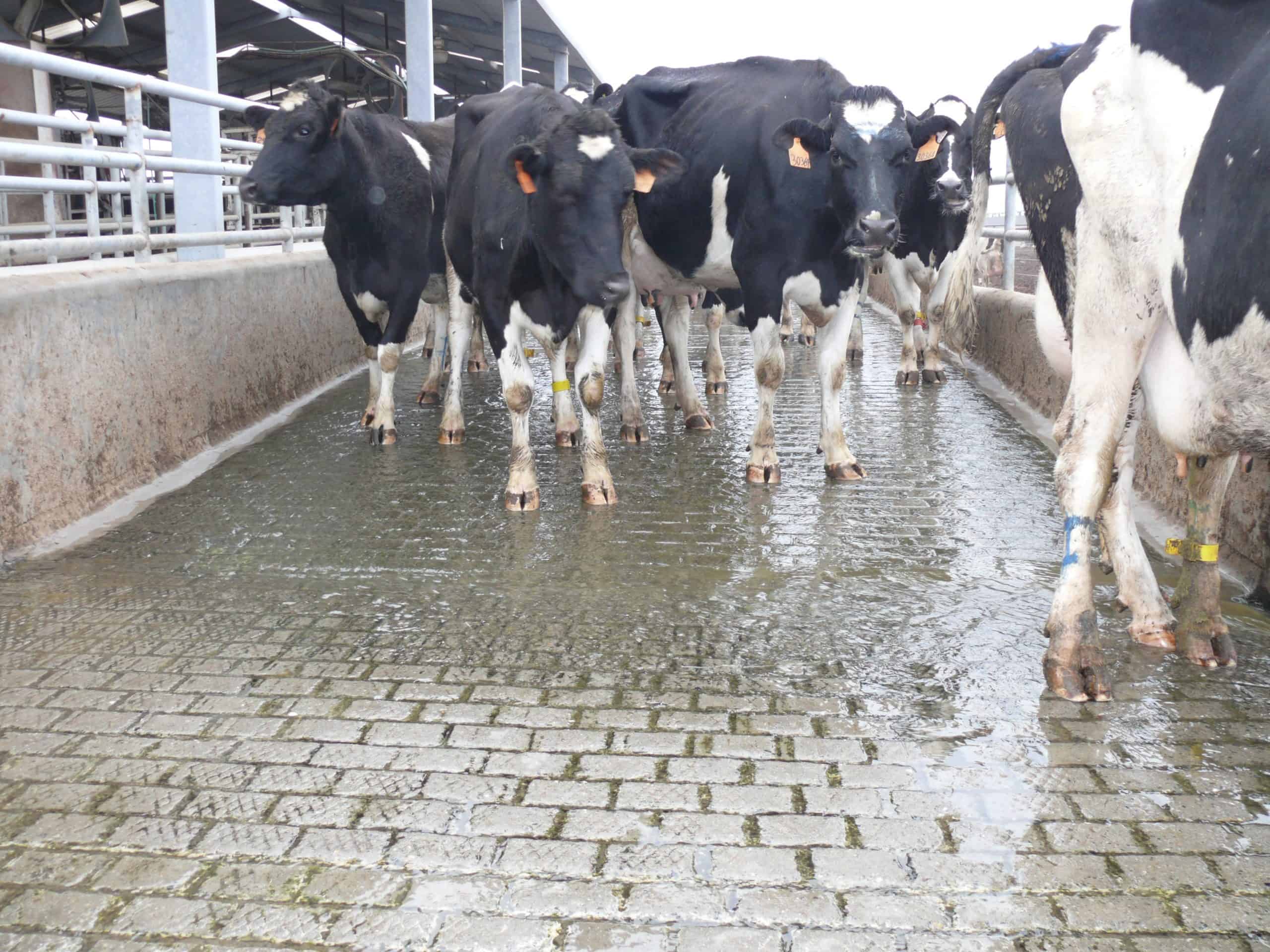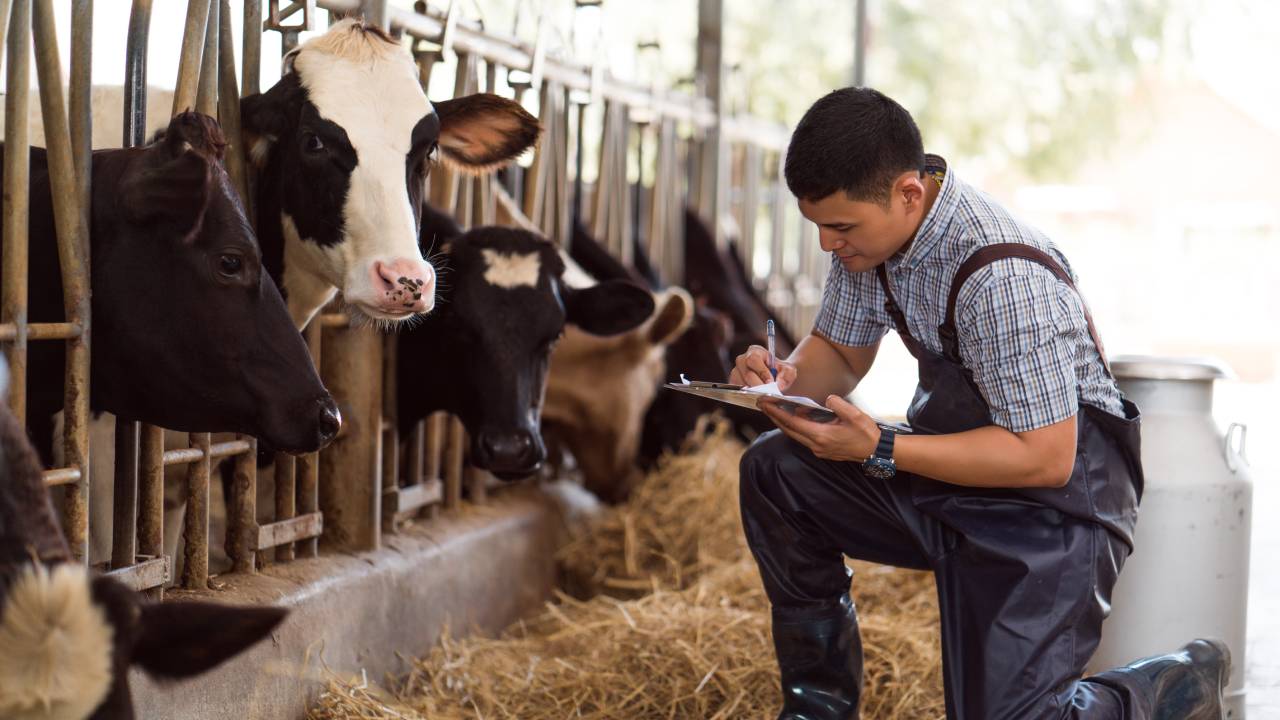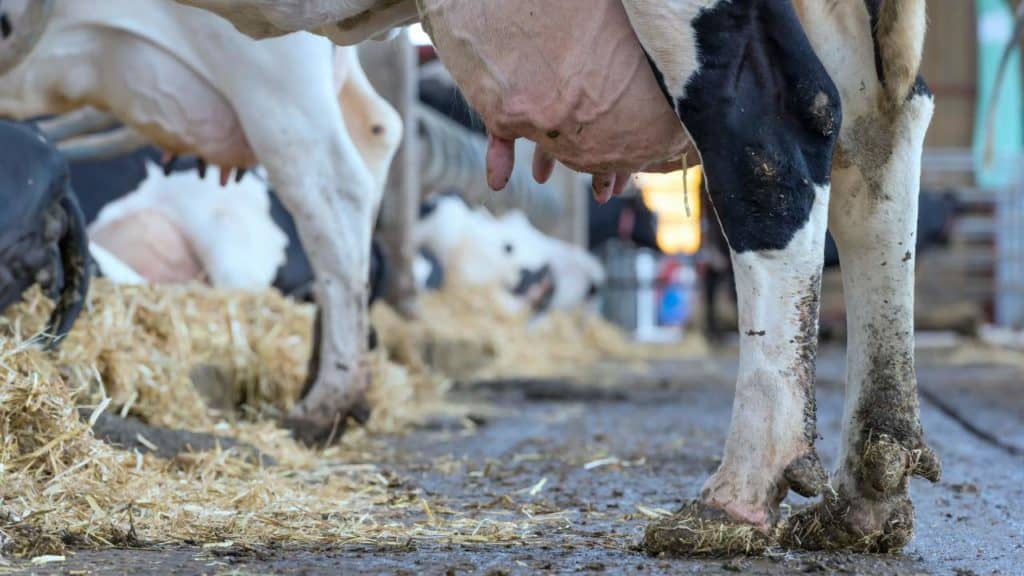
Digital dermatitis, often referred to as "hairy heel warts," is a common and highly contagious infectious foot disease that afflicts cattle, especially on dairy farms. This disease, characterized by ulcerative and necrotizing foot lesions, is primarily caused by bacteria known as treponemes.
In this comprehensive guide, we will explore the various aspects of digital dermatitis, including its causes, identification, symptoms, types of lesions, transmission among cows, prevention, treatment, and the economic benefits of prioritizing prevention. By gaining a deep understanding of digital dermatitis and implementing effective management strategies, dairy farm owners can ensure the health and well-being of their cows while safeguarding the sustainability of their operations.

Digital dermatitis is a highly contagious infectious foot disease that primarily affects cattle. It targets the skin on the rear feet, with a particular focus on the bulbs of the heel and the interdigital space. This disease is caused by a group of bacteria collectively referred to as treponemes. Treponemes thrive in environments characterized by moisture and poor hygiene, making dairy farms with suboptimal cleanliness and foot care practices particularly susceptible.
Understanding the root causes of digital dermatitis is crucial for its prevention and management. Several factors contribute to the development and spread of this condition:
Treponemes, specifically Treponema pedis, Treponema medium, and Treponema phagedenis, are the primary causative agents behind digital dermatitis. These bacteria colonize the skin on the rear feet, particularly in areas where lesions develop.
High moisture levels and soiled conditions in the barn or holding areas create an ideal breeding ground for treponemes. These bacteria thrive in damp environments, and the presence of manure further exacerbates the problem.
Poor hoof hygiene practices, such as infrequent cleaning and trimming, can lead to the accumulation of dirt and manure. This accumulation provides a fertile environment for treponemes to multiply and invade the skin.
Cows in close proximity and shared walking paths facilitate the transmission of the bacteria among animals. Direct contact between infected and healthy cows can lead to the rapid spread of digital dermatitis within a herd.
Recognizing digital dermatitis lesions early is vital for prompt intervention and effective control. The following are key signs to look for:
Initial lesions appear as small, raised, and hair-like growths on the skin of the heel and interdigital space. These growths are often painless at this stage but serve as an entry point for treponemes.
As the disease progresses, these lesions become painful ulcers, often accompanied by a foul-smelling discharge. The ulcers are a result of tissue damage caused by the bacteria, and they can cause significant discomfort to affected cows.
One of the most noticeable signs of digital dermatitis is lameness. Affected cows will exhibit varying degrees of lameness, ranging from mild to severe, depending on the lesion's location and size. Lameness can significantly impact a cow's quality of life and productivity.
Cows with digital dermatitis often avoid putting weight on the affected foot, further exacerbating their discomfort. This reluctance to bear weight is a defensive response to the pain associated with active lesions.
Early diagnosis is crucial to effectively managing digital dermatitis and preventing its spread within the herd. Veterinarians typically diagnose the condition through visual examination and clinical signs. Key indicators include the presence of painful and ulcerative lesions on the hooves, as well as lameness in affected cows. Biopsy samples and polymerase chain reaction (PCR) tests can also be used to confirm the presence of treponemes.
Digital dermatitis is notorious for its rapid spread within a herd. Cows in close proximity are at higher risk of infection, and once one cow is affected, others can quickly follow suit. Detecting and addressing the disease early can:
Lameness caused by digital dermatitis can be excruciatingly painful for cows. Early diagnosis means prompt treatment, which alleviates pain and improves the welfare of your herd.
Identifying and isolating affected cows early can prevent the disease from spreading within the herd. This not only protects healthy cows but also reduces treatment costs.
Lameness often leads to reduced milk production. By addressing digital dermatitis promptly, you can help maintain your herd's milk yield and, in turn, your farm's profitability.
Healthy cows are productive cows. Early detection and treatment of digital dermatitis contributes to the overall productivity and longevity of your dairy herd.

Early detection begins with regular and vigilant monitoring of your herd. Here are some steps to help you spot digital dermatitis in its initial stages:
Train your staff to inspect the hooves and interdigital spaces of your cows regularly. Look for any signs of swelling, redness, or early lesions. Catching these issues before they progress is key.
Maintain detailed records of each cow's hoof health. This allows you to track changes over time and quickly identify any cows showing signs of digital dermatitis.
Implement a lameness scoring system on your farm. This involves regularly evaluating the gait and mobility of your cows. Any signs of lameness should be investigated promptly.
Regular consultations with a veterinarian who is experienced in dairy cow health are invaluable. They can provide guidance on early detection and recommend appropriate treatments.
Early detection of digital dermatitis is crucial for several reasons:
Early intervention can alleviate pain and suffering in affected cows.
Isolating infected cows early can help prevent the rapid transmission of the disease.
Treating digital dermatitis in its early stages is often more cost-effective than addressing advanced lesions.
Digital dermatitis can manifest in different forms, each with distinct characteristics:
Active lesions are characterized by red, painful, and ulcerative areas on the skin of the rear feet. These lesions are highly contagious and require immediate attention to prevent further spread within the herd. Active lesions are typically the initial stage of digital dermatitis.
As lesions start to heal, they form scabs or warts, which are less contagious than active lesions. To minimize relapses, however, monitoring and treatment should continue until complete recovery. Healing lesions represent a transitional stage in the disease's progression.
Untreated or inadequately managed digital dermatitis can lead to chronic lesions. These lesions are characterized by extensive tissue damage and severe lameness. Chronic cases are challenging to manage and may necessitate culling, as they can severely impact a cow's overall well-being.

Digital dermatitis spreads easily among cows within a herd due to its highly contagious nature. The primary modes of transmission include:
Cows can transmit the disease to one another through close physical contact, especially when cows congregate in groups or during milking. Even brief contact with an infected cow can lead to the transmission of treponemes.
Dirty, damp environments that house multiple cows facilitate the spread of treponemes. Manure-laden areas and contaminated bedding are prime sources of transmission. Cows walking through these areas can pick up the bacteria on their hooves, leading to new infections.
Contaminated manure and moisture act as carriers for treponemes, further spreading the disease as cows walk through these substances. Manure serves as a source of bacterial contamination, and moist conditions provide an ideal environment for treponemes to thrive.
Prevention is undoubtedly the most effective strategy for managing digital dermatitis and minimizing its impact on your dairy farm. Here are key preventive measures:
Regularly clean and disinfect barns, walkways, and holding areas. Ensure proper drainage to minimize moisture buildup, as treponemes thrive in wet environments. Implement a strict cleaning schedule to remove manure and organic matter from the environment.
Implement a routine hoof trimming schedule to prevent overgrowth and remove excess dirt. Proper hoof care can significantly reduce the risk of infection. Regularly inspect and clean the hooves of all cows in the herd.
Set up footbaths with effective disinfectants like copper sulfate or formalin. Ensure that cows walk through them regularly to reduce the treponeme load on their hooves. Properly maintained footbaths are a critical component of digital dermatitis prevention.
Identify and isolate cows with active lesions to prevent further transmission within the herd. Isolation also allows for targeted treatment and monitoring. Isolated cows should have their own designated space and caregivers to minimize contact with healthy animals.
Ensure cows receive a balanced diet to support their overall health and immune system. Proper nutrition is essential to minimize stress and enhance the cow's ability to resist infections. Consult with a nutritionist to optimize the diet for your herd's specific needs.
Providing cows with ample space can minimize direct contact and reduce the risk of transmission.
Conduct routine checks of all cows for signs of digital dermatitis, and address any cases immediately.
While prevention is the best approach, treatment is necessary for affected cows to alleviate pain and minimize the disease's progression. Treatment options include:
Application of antibiotics directly to the lesions can help control the infection. Consult with a veterinarian for proper antibiotic selection and application techniques. Early and aggressive treatment can improve the chances of a successful recovery.
Bandaging and foot wraps may be used to protect and treat active lesions, aiding in the healing process. Ensure that wraps are clean and changed regularly to prevent further contamination. Foot wraps are particularly useful for managing severe cases.
Provide pain relief to affected cows to improve their comfort and encourage weight-bearing on the affected foot. Non-steroidal anti-inflammatory drugs (NSAIDs) can be prescribed by a veterinarian. Pain management is essential to enhance the cow's quality of life during recovery.
Preventing digital dermatitis is not only more humane but also more cost-effective than dealing with its consequences. The expenses associated with the treatment of chronic cases, reduced milk production due to lameness, and potential culling of severely affected cows can significantly impact a dairy farm's bottom line.
Treating digital dermatitis can be expensive, involving the purchase of antibiotics, bandaging materials, and veterinary services. Additionally, the labor required for treatment can be substantial.
Cows affected by digital dermatitis may experience reduced milk production due to the discomfort and lameness associated with the disease. This reduction in milk yield can lead to substantial financial losses for the dairy farm.
In severe cases, cows with chronic digital dermatitis lesions may need to be culled from the herd. Culling not only results in the loss of an animal but also incurs additional costs associated with disposal and replacement.
Digital dermatitis can have a long-term impact on herd health. The presence of infected cows can perpetuate the cycle of infection, increasing the risk of new cases and making it challenging to maintain a healthy herd.
By investing in preventive measures and maintaining proper hygiene, dairy farmers can save both money and their cows' well-being.

Several factors can influence the spread and severity of digital dermatitis within a dairy herd:
Larger herds are at greater risk due to increased cow-to-cow contact, but proper management practices can mitigate this risk. Implementing effective preventive measures becomes even more critical in larger herds.
Farms with lax hygiene practices are more susceptible to outbreaks. Strict adherence to cleaning and disinfection protocols is essential. Training farm personnel in proper hygiene practices can significantly reduce the risk of infection.
Wet and muddy environments create an ideal breeding ground for treponemes. Improving drainage and maintaining cleanliness is crucial. Proper barn design and layout can also help minimize environmental risk factors.
Stressed cows are more vulnerable to infections, so proper nutrition, stress management, and adequate housing are essential to minimize stressors. Identifying and addressing sources of stress within the herd can contribute to disease prevention.
Implementing robust biosecurity measures can reduce the introduction of treponemes to the herd. This includes controlling access to the farm, screening new additions to the herd, and regularly monitoring the health of all cows.
In this section, we'll provide you with expert tips and insights on managing digital dermatitis effectively.
If you introduce new cows to your herd, it's essential to quarantine them for a period of time before integrating them with the rest of the cows. This quarantine period helps ensure that any potential carriers of digital dermatitis do not introduce the disease to your existing herd.
Hoof health is crucial in preventing digital dermatitis. Ensure that your cows receive regular hoof trimming to prevent overgrowth and reduce the risk of lesions. A well-maintained hoof is less likely to develop problems.
Keep a close eye on environmental conditions within your dairy farm. Implement drainage systems to reduce wet and muddy areas, which can serve as breeding grounds for treponemes. Well-maintained, dry living conditions are a significant step towards preventing the disease.
Educate your farm staff about the signs and symptoms of digital dermatitis. Regular training can help them identify early stages of the disease and take appropriate action promptly.
Stay updated on the latest research and developments related to digital dermatitis. New treatments and prevention strategies may emerge, and it's essential to incorporate the most effective methods into your farm's management practices.
In addition to prevention, have a clear treatment protocol in place for cows that do develop digital dermatitis. Work closely with your veterinarian to ensure that treatments are administered correctly and promptly.
Understanding the financial impact of digital dermatitis on your dairy farm is crucial for effective management. Let's break down how this disease can affect your bottom line:
Lameness caused by digital dermatitis often results in reduced milk production. Affected cows may spend more time lying down and less time feeding, leading to lower milk yields.
Treating digital dermatitis can be costly, especially if multiple cows are affected. The expenses include medications, bandages, and labor costs for treatment.
Cows suffering from digital dermatitis may have a shorter productive lifespan due to lameness and related health issues. This leads to the need for more replacements, which can be expensive.
An outbreak of digital dermatitis can disrupt the overall health and productivity of your herd. Stress from the disease can make cows more susceptible to other health issues.
Managing and treating digital dermatitis requires additional labor. This can strain your farm's resources and workforce.
A high prevalence of digital dermatitis can harm your farm's reputation. Buyers and consumers often associate healthy cows with quality dairy products.

Digital dermatitis is a significant challenge in the dairy farming industry, but it's one that can be managed and controlled with the right knowledge and practices. By understanding the causes, symptoms, prevention strategies, and economic impact of digital dermatitis, you can take proactive steps to protect the health of your cows and the profitability of your dairy farm.
Remember that early detection, effective prevention, and expert guidance are key elements in the battle against digital dermatitis. Your commitment to hoof health and hygiene will not only benefit your cows but also contribute to the long-term success of your dairy operation.
Managing digital dermatitis requires a comprehensive and proactive approach. AgroChem is your trusted partner in the fight against digital dermatitis. Our team of experts specializes in supplying chemicals and formulated products tailored to the unique hygiene challenges faced by dairy farms.
By contacting AgroChem, you gain access to:
Our team understands the intricacies of digital dermatitis and can provide customized solutions for your farm.
We offer a range of products designed to prevent, treat, and control digital dermatitis effectively.
Don't let digital dermatitis jeopardize the well-being of your cows and the profitability of your dairy farm. Contact AgroChem today and take proactive steps towards preventing, managing, and controlling this challenging disease.